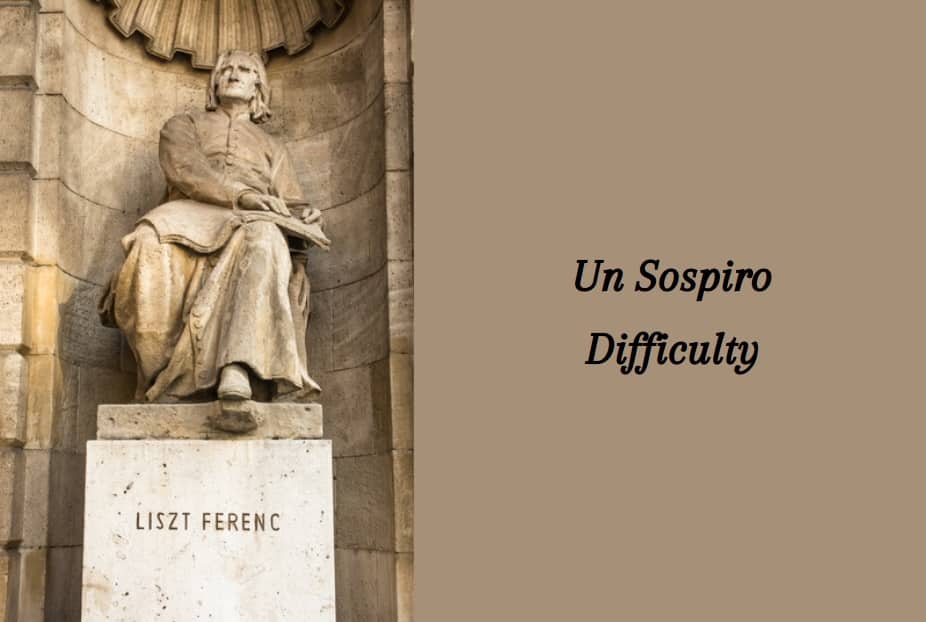
Franz Liszt gained a formidable and deserved reputation during his long life, as a virtuoso pianist and composer. For many pianists studying and performing the music of Liszt presents one of the most demanding challenges they could ever hope to meet. It might be reasonable to describe Liszt as the Romantic icon, with dashing good looks, almost unmatched abilities on the piano, and master of the high drama and pathos in favor at the time.
Liszt composed extensively for his instrument and whilst some of his pieces are seemingly unpayable when first looking at the mass of black lines on the score, others turn out not to be as terrifying as they appear.
Un Sospiro Difficulty
The piece under the spotlight here is Franz Liszt’s ‘Un Sospiro’ or a sigh. It was composed between 1845 and 1849 but according to many sources, Liszt did not give the title to the piece himself even though it is rather fitting. It is a poetic piece the kind that Liszt creates so well although essentially it is a concert study.
‘Un Sospiro’ is the third piece in Liszt’s set of Concert Études that were originally published under the more inspired title ‘Trois Caprices Poetiques’. The dedication Liszt makes is to his uncle Eduard Liszt.
We learn more about the piece when we consider the reasons why Liszt wrote it. An étude or study is a piece that is composed with the specific intention of addressing a particular aspect of technique. ‘Un Sospiro’ Liszt wrote to challenge pianists with the technique known as ‘cross-hands’. What this means is that often the right hand of the pianist plays down to the bass notes and in turn, the left-hand crosses over the right hand to play the higher notes of the piano. In some editions, the notation includes a third staff where notes that have stems down are for the left-hand and stems up for the right-hand.
Besides, the melody flows from one hand to another creating another technical challenge as ensuring the accents, dynamics, and phrasing of the melodic line are consistent is no elementary task. This is especially true when you consider the tempo marking as ‘Allegro affettuoso’ coupled with the direction of ‘agitato’ or agitated. Perhaps more than this is the knowledge that Liszt felt strongly that his music should be performed.
A genuine display of theatrics would not have been uncommon if you had attended a concert by the composer. The drama is an integral part of the other technical demands that sometimes are overlooked in favor of pure speed. That said, Liszt offers the pianist ample opportunity for display in the mini-cadenzas that act as links between the sections. These are momentary, virtuosic flurries that Liszt would have dazzled his audience by playing now give that chance to 21st-century performers. They are not an easy and careful observation of the fingering is advised.
Technicalities duly noted and certainly not ignored, it is the interpretation of ‘Un Sospiro’ that can be as much of a task to succeed with as the other elements. For many people, this piece has distinct ‘impressionistic’ qualities with the ebb and flow of the accompanying arpeggio patterns and the delicate but enigmatic melody.
Not only do you need to possess full command of the fingering required to play the music but the imagination and innovation needed to bring the written notes to life avoiding sentimentality and raw technique.
There is a picture to paint in ‘Un Sospiro’ with a multitude of hidden layers of emotion that if overlooked can make the composition sound banal. If we are to interpret ‘Un Sospiro’ literally, could we as performers hear the flowing arpeggios as the soft intake and exhalation of air? Do we approach ‘Un Sospiro’ with an orchestral sound palette in mind thinking of the accompanying patterns like a cascading harp and the melodies in pizzicato strings and light percussion perhaps? However you feel the most accurate and appropriate direction to take, there is no doubt as to the number of different renditions of the work indicating just how much care needs to be taken over its preparation.
I find the ‘Henle’ website an invaluable source of information when considering the difficulty of a piece of music. They rate compositions on a scale of 1 – 9 with ‘Un Sospiro’ emerging at a 7 to 8 on their scale. At one time, and indeed it still might be, ‘Un Sospiro’ was at the Diploma level in the ABRSM (Associated Board of The Royal School of Music), listings placing at a level of high demand and challenge. The ABRSM is a very reliable source of information on the difficulties, in every sense of the word, of music. Placing the Liszt work at one of the highest levels of performance achievement certainly gives food for thought when deciding to learn the work or not.
From a substantial number of piano forums, there seems to be a broad agreement amongst pianists that ‘Un Sospiro’ together with the other two Concert Études are amongst the most technically difficult pieces that Liszt composed. What is also clear is that once the time and patience have been devoted to learning and mastering the technicalities, the work falls under the fingers quite nicely.
Liszt rarely instructed his students in matters of technique, instead preferring to concentrate on interpretation. It seems to me that Liszt would expect any pianist who wanted to play ‘Un Sospiro’, to be taking study time to think through how to play it from this perspective, not one of where to put your fingers.
‘Un Sospiro’ is not for the faint-hearted, and certainly not written with inexperienced pianists in mind. It was one of Liszt’s favorite pieces and he included it in his recitals many times. This in itself is an indicator of the difficulties that live in the piece but also the ultimate musical prize when all the hard work falls beautifully into place.
